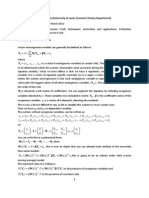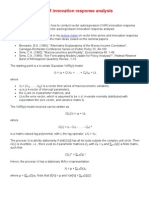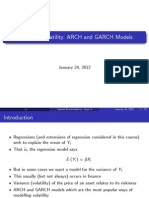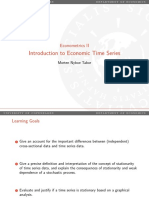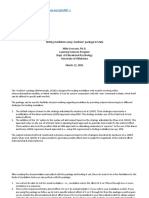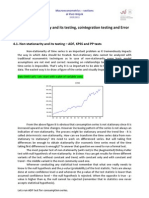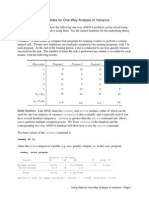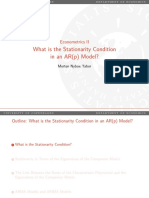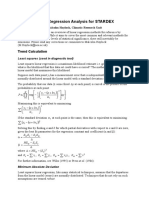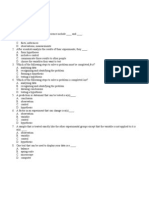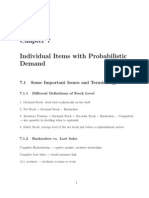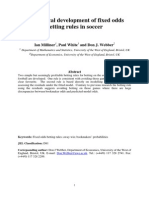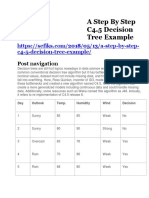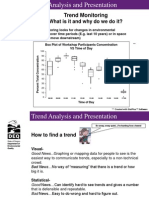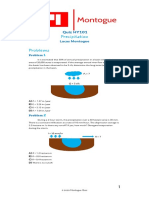Structural VAR and Applications: Jean-Paul Renne
Structural VAR and Applications: Jean-Paul Renne
Uploaded by
runawayyyCopyright:
Available Formats
Structural VAR and Applications: Jean-Paul Renne
Structural VAR and Applications: Jean-Paul Renne
Uploaded by
runawayyyOriginal Title
Copyright
Available Formats
Share this document
Did you find this document useful?
Is this content inappropriate?
Copyright:
Available Formats
Structural VAR and Applications: Jean-Paul Renne
Structural VAR and Applications: Jean-Paul Renne
Uploaded by
runawayyyCopyright:
Available Formats
Structural VAR and Applications
Jean-Paul Renne
Banque de France
ENSTA, 22 January 2010
Jean-Paul Renne (Banque de France) Structural VAR and Applications ENSTA, 22 January 2010 1 / 55
Overview of the presentation
1
Vector Auto-Regressions
Denition
Estimation
Tests
2
Impulse responses
General concept
Application to Structural VAR
3
Applications
1 Blanchard and Quah (1989)
2 Smets and Tsatsaronis (1997)
3 Dedola and Lippi (2005)
Jean-Paul Renne (Banque de France) Structural VAR and Applications ENSTA, 22 January 2010 2 / 55
Structural VAR
Vector Auto-Regressions: Short introduction
The VAR are widely used in economic analysis.
While simple and easy to estimate, they make it possible to
conveniently capture the dynamics of multivariate systems.
VAR popularity is mainly due to Sims (1980) inuential work.
Jean-Paul Renne (Banque de France) Structural VAR and Applications ENSTA, 22 January 2010 3 / 55
Structural VAR
Vector Auto-Regressions: Notations
let y
t
denote an (n 1) vector of random variables. y
t
follows a p
th
order Gaussian VAR if, for all t, we have
y
t
= c +
1
y
t1
+ . . .
p
y
tp
+
t
where
t
N(0, ).
Consequently
y
t
| y
t1
, y
t2
, . . . , y
p+1
N(c +
1
y
t1
+ . . .
p
y
tp
, ).
Denoting with the matrix
_
c
1
2
. . .
p
and with x
t
the
vector
_
1 y
t1
y
t2
. . . y
tp
, the log-likelihood is given by
L(Y
T
; ) = (Tn/2) log(2) + (T/2) log
1
2
T
t=1
_
_
y
t
x
t
_
1
_
y
t
x
t
_
_
.
Jean-Paul Renne (Banque de France) Structural VAR and Applications ENSTA, 22 January 2010 4 / 55
Structural VAR
Vector Auto-Regressions: Maximum Likelihood Estimation (MLE)
The MLE of , denoted with
is given by
=
_
T
t=1
y
t
x
t
__
T
t=1
x
t
x
t
_
1
. (1)
Exercise 1
After having computed the j
th
rows of
, nd an easy way to
estimate
.
Jean-Paul Renne (Banque de France) Structural VAR and Applications ENSTA, 22 January 2010 5 / 55
Structural VAR
Vector Auto-Regressions: Maximum Likelihood Estimation (MLE)
Proof of equation (1)
Lets rewrite the last term of the log-likelihood
T
t=1
_
_
y
t
x
t
_
1
_
y
t
x
t
_
_
=
T
t=1
_
_
y
t
x
t
+
x
t
x
t
_
1
_
y
t
x
t
+
x
t
x
t
_
_
=
T
t=1
_
_
t
+ (
x
t
1
_
t
+ (
x
t
_
_
where the j
th
element of the (n 1) vector
t
is the sample residual for
observation t from an OLS regression of y
jt
on x
t
.
Jean-Paul Renne (Banque de France) Structural VAR and Applications ENSTA, 22 January 2010 6 / 55
Structural VAR
Vector Auto-Regressions: Maximum Likelihood Estimation (MLE)
T
t=1
_
_
y
t
x
t
_
1
_
y
t
x
t
_
_
=
T
t=1
1
t
+ 2
T
t=1
1
(
x
t
+
T
t=1
x
t
(
)
1
(
x
t
Jean-Paul Renne (Banque de France) Structural VAR and Applications ENSTA, 22 January 2010 7 / 55
Structural VAR
Vector Auto-Regressions: Maximum Likelihood Estimation (MLE)
Lets apply the trace operator on the second term (that is a scalar):
T
t=1
1
(
x
t
= trace
_
T
t=1
1
(
x
t
_
= trace
_
T
t=1
1
(
x
t
t
_
= trace
_
1
(
t=1
x
t
t
_
Jean-Paul Renne (Banque de France) Structural VAR and Applications ENSTA, 22 January 2010 8 / 55
Structural VAR
Vector Auto-Regressions: Maximum Likelihood Estimation (MLE)
Given that, by construction, the sample residuals are orthogonal to the
explanatory variables, this term is equal to zero.
If x
t
= (
x
t
, we have
T
t=1
_
_
y
t
x
t
_
1
_
y
t
x
t
_
_
=
T
t=1
1
t
+
T
t=1
x
1
x
t
Since is a positive denite matrix,
1
is as well. Consequently, the
smallest value that the last term can take is obtained when x
t
= 0,ie when
=
.
Jean-Paul Renne (Banque de France) Structural VAR and Applications ENSTA, 22 January 2010 9 / 55
Structural VAR
Vector Auto-Regressions: Maximum Likelihood Estimation (MLE)
Assume that we have computed
, the MLE of is the matrix
that
maximizes
L(Y
T
;
, ).
Denoting with
t
the estimated residual y
t
x
t
, we have
L(Y
T
;
,) = (Tn/2) log(2) + (T/2) log
1
2
T
t=1
_
1
t
is a symmetric positive denite matrix. Fortunately, it turns out
that that the unrestricted matrix that maximizes the latter expression
is a symmetric postive denite matrix. Indeed,
()
=
T
2
1
2
T
t=1
t
t
=
=
1
T
T
t=1
t
t
.
Jean-Paul Renne (Banque de France) Structural VAR and Applications ENSTA, 22 January 2010 10 / 55
Structural VAR
Vector Auto-Regressions: Likelihood-Ratio test
The simplicity of the VAR framework and the tractability of its MLE
contribute to convenience of various econometric tests. We illustrate
this here with the likelihhod ratio test.
The maximum value achieved by the MLE is
L(Y
T
;
,
) = (Tn/2) log(2) + (T/2) log
1
2
T
t=1
_
1
t
_
.
Jean-Paul Renne (Banque de France) Structural VAR and Applications ENSTA, 22 January 2010 11 / 55
Structural VAR
Vector Auto-Regressions: Likelihood-Ratio test
The last term is
T
t=1
1
t
= trace
_
T
t=1
1
t
_
= trace
_
T
t=1
1
t
t
_
= trace
_
1
T
t=1
t
t
_
= trace
_
1
_
T
__
= Tn.
Therefore
L(Y
T
;
,
) = (Tn/2) log(2) + (T/2) log
Tn/2.
which is easy to calculate.
Jean-Paul Renne (Banque de France) Structural VAR and Applications ENSTA, 22 January 2010 12 / 55
Structural VAR
Vector Auto-Regressions: Likelihood-Ratio test
For instance, assume that we want to test the null hypothesis that a
set of variable follows a VAR(p
0
) against the alternative specication
of p
1
lags (with p
1
> p
0
).
Let us respectively denote with
L
0
and
L
1
the maximum log-likelihoods
obtained withp
0
and p
1
lags. Under the null hypothesis, we have
2
_
L
1
L
0
_
= T
_
log
1
1
log
1
0
_
which asymptotically has a
2
distribution with degrees of freedom
equal to the number of restrictions imposed under H
0
(compared with
H
1
), ie n
2
(p
1
p
0
).
Jean-Paul Renne (Banque de France) Structural VAR and Applications ENSTA, 22 January 2010 13 / 55
Structural VAR
Vector Auto-Regressions: Unconditional variance
The unconditional matrix of variance-covariance of y
t
is
Var (y) = lim
t
E
0
((y
t
y
t
)(y
t
y
t
)
)
where y
t
denotes the unconditional mean of y.
Let denote with y
t
the vector
_
y
t
y
t1
. . . y
tp
, we have
y
t
=
_
_
c
0
.
.
.
0
_
_
+
_
1
2
p
1 0 0
0
.
.
.
0 0
0 0 1 0
_
_
y
t1
+
_
t
0
.
.
.
0
_
_
y
t
= c
+y
t1
+
t
Jean-Paul Renne (Banque de France) Structural VAR and Applications ENSTA, 22 January 2010 14 / 55
Structural VAR
Vector Auto-Regressions: Unconditional variance
It is then easy to get the Wolds decomposition of y
t
:
y
t
= c
+
_
c
+y
t2
+
t1
_
+
t
= c
t
+(c
t1
) + . . . +
k
(c
tk
) + . . .
The
t
s being iid, we have
Var (y) = +
+ . . . +
k
k
+ . . .
Jean-Paul Renne (Banque de France) Structural VAR and Applications ENSTA, 22 January 2010 15 / 55
Structural VAR
Vector Auto-Regressions: Criteria
In a VAR, adding lags quickly consume degrees of freedom. If lag
length is p, each of the n equations contains n p coecients plus
the intercept term.
Adding lengths improve in-sample t, but is likely to result in
over-parameterization and aect the out-of-sample prediction
performance.
To select appropriate lag length, some criteria can be used (they have
to be minimized)
AIC = log
+
2
T
N
SBIC = log
+
log T
T
N
where N = n p
2
+ p.
Jean-Paul Renne (Banque de France) Structural VAR and Applications ENSTA, 22 January 2010 16 / 55
Structural VAR
Vector Auto-Regressions: Granger Causality
Granger (1969) developed a method to analyze the causal relationship
among variables systematically.
The approach consists in determining whether the past values of y
1,t
can help to explain the current y
2,t
.
Let us denote three information sets
I
1,t
= {y
1,t
, y
1,t1
, . . .}
I
2,t
= {y
2,t
, y
2,t1
, . . .}
I
t
= {y
1,t
, y
1,t1
, . . . y
2,t
, y
2,t1
, . . .} .
We say that y
1,t
Granger-causes y
2,t
if
E [y
2,t
| I
2,t1
] = E [y
2,t
| I
t1
] .
Jean-Paul Renne (Banque de France) Structural VAR and Applications ENSTA, 22 January 2010 17 / 55
Structural VAR
Vector Auto-Regressions: Unconditional variance
To get the intuition behind the testing procedure, consider the
following bivariate VAR(p) process:
y
1,t
=
10
+
p
i =1
11
(i )y
1,ti
+
p
i =1
12
(i )y
2,ti
+ u
1,t
y
2,t
=
20
+
p
i =1
21
(i )y
1,ti
+
p
i =1
22
(i )y
2,ti
+ u
2,t
.
Then,y
1,t
does not Granger-cause y
2,t
if
21
(1) =
21
(2) = . . . =
21
(p) = 0.
Therefore the hypothesis testing is
_
H
0
:
21
(1) =
21
(2) = . . . =
21
(p) = 0
H
A
:
21
(1) = 0 or
21
(1) = 0 or . . .
21
(p) = 0.
Jean-Paul Renne (Banque de France) Structural VAR and Applications ENSTA, 22 January 2010 18 / 55
Structural VAR
Vector Auto-Regressions: Unconditional variance
Rejection of H
0
implies that some of the coecients on the lagged
y
1,t
s are statistically signicant.
This can be tested using the F-test or asymptotic chi-square test.
The F-statistic is F =
(RSSUSS)/p
USS/(T2p1)
(where RSS: restricted residual
sum of squares, USS: unrestriced residual sum of squares)
Under H
0
, the F-statistic is distributed as F(p, T 2p 1)
In addition, pF
2
(p).
Jean-Paul Renne (Banque de France) Structural VAR and Applications ENSTA, 22 January 2010 19 / 55
Structural VAR
Vector Auto-Regressions: Impulse responses
Objective: analyzing the eect of a given shock on the endogenous
variables.
Let us consider a random variable y
t
that presents the following
Wolds decomposition:
y
t
=
k=0
tk
.
The impulse response function of the shock
t
on y
t
, y
t+1
, . . . is given
by the matrices
k
.
Formally, the impulse response of the shock
t
on the variable y is
dened as
y
t+k
t
=
k
.
Jean-Paul Renne (Banque de France) Structural VAR and Applications ENSTA, 22 January 2010 20 / 55
Structural VAR
Vector Auto-Regressions: Impulse responses
Dynamics of y
t
, y
t+1
, y
t+2
, . . . when
t
= 1,
t+1
= 0,
t+2
= 0, . . .
! !
4
!
4
"
4
#
y
t
y
t+1
y
t+2
y
t+3
y
t+4
y
t+5
y
t+6
Jean-Paul Renne (Banque de France) Structural VAR and Applications ENSTA, 22 January 2010 21 / 55
Structural VAR
Vector Auto-Regressions: Impulse responses
Exercise 2
Consider the process
y
t
= 1 + 0.9y
t1
+
t
.
Compute the unconditional mean and variance of y
t
.
Exercise 2
Consider the process
y
t
= 1 + 0.5y
t1
+ 0.4y
t2
+
t
.
Draw the impulse response of y
t
to
t
(up to y
t+3
). What is the
cumulated impact of a shock (
t
= 1,
t+1
= 0,
t+2
= 0, . . .) on
y
t
?
Jean-Paul Renne (Banque de France) Structural VAR and Applications ENSTA, 22 January 2010 22 / 55
Structural VAR
Vector Auto-Regressions: Causal mechanisms
Assume that the GDP growth g
t
is aected by some real shocks u
r,t
following
g
t
= 0.3(i
t1
t
) + u
r,t
where i
t
denotes the nominal interest rate and
t
denotes the ination
rate.
Besides, assume that we have
i
t
= 0.9i
t1
+ 1.5
t
+ u
mp,t
t
= 0.9
t1
+ 0.2g
t1
+ u
n,t
where u
mp,t
and u
n,t
are respectively some monetary-policy and
cost-push shocks.
The strucural shocks u
t
are uncorrelated (i.e., the covariance matrix of
u
t
, denoted with
u
is diagonal) and u
t
is serially uncorrelated (i.e.
Cov(u
tk
, u
t
) = 0 for any t and k > 0).
Jean-Paul Renne (Banque de France) Structural VAR and Applications ENSTA, 22 January 2010 23 / 55
Structural VAR
Vector Auto-Regressions: Causal mechanisms
The structural model reads
_
_
g
t
= 0.3(i
t1
t
) + u
r ,t
i
t
= 0.9i
t1
+ 1.5
t
+ u
mp,t
t
= 0.9
t1
+ 0.2g
t1
+ u
n,t
.
To get it in a reduced-form, let us substitute
t
in the right-hand
sides of the rst two equations:
_
_
g
t
= 0.06g
t1
0.3i
t1
+ 0.27
t1
+ 0.3u
n,t
+ u
r,t
i
t
= 0.9i
t1
+ 1.35
t1
+ 0.3g
t1
+ u
mp,t
+ 1.5u
n,t
t
= 0.9
t1
+ 0.2g
t1
+ u
n,t
.
Jean-Paul Renne (Banque de France) Structural VAR and Applications ENSTA, 22 January 2010 24 / 55
Structural VAR
Vector Auto-Regressions: Causal mechanisms
Exercise 3
Write the model in matrix form.
Is this economy stationary?
Propose a way of estimating the model.
How to recover the structural shocks u
t
?
Jean-Paul Renne (Banque de France) Structural VAR and Applications ENSTA, 22 January 2010 25 / 55
Structural VAR
Vector Auto-Regressions:Impulse responses
In matrix form
_
_
g
t
i
t
t
_
_
=
_
_
0.06 0.3 0.27
0.3 0.9 1.35
0.2 0 0.9
_
_
_
_
g
t1
i
t1
t1
_
_
+
_
_
g,t
i ,t
,t
_
_
with
_
_
g,t
i ,t
,t
_
_
=
_
_
1 0 0.3
0 1 1.5
0 0 1
_
_
_
_
u
r,t
u
mp,t
u
n,t
_
_
= B
_
_
u
r,t
u
mp,t
u
n,t
_
_
.
With the procedure described above, one only gets an estimate of
where
= Var
_
_
_
_
g,t
i ,t
,t
_
_
_
_
.
Jean-Paul Renne (Banque de France) Structural VAR and Applications ENSTA, 22 January 2010 26 / 55
Structural VAR
Vector Auto-Regressions:Impulse responses
Note however that we must have
= B
u
B
where
u
is diagonal positive.
In addition, given the structural framework, one knows that B is an
upper-triangular matrix.
The Choleshy decomposition can therefore be used to get the B
matrix.
Jean-Paul Renne (Banque de France) Structural VAR and Applications ENSTA, 22 January 2010 27 / 55
Structural VAR
Vector Auto-Regressions:Impulse responses
Whereas the VAR model is able to capture eciently the interactions
between the dierent variables, it does not allow to reveal the
underlying causal mecanisms since two dierent causal schemes can
correspond to the same reduced forms.
By taking into account certain economic relationships, a Structural
VAR model (SVAR) makes it possible to identify structural shocks
while letting play the interactions between the dierent variables (see
Gali, 1992 or Gerlach and Smets 1995).
Formally, let assume that the residuals
t
are some linear combinations
of the structural shocks u
t
, that is:
t
= Bu
t
.
Jean-Paul Renne (Banque de France) Structural VAR and Applications ENSTA, 22 January 2010 28 / 55
Structural VAR
Vector Auto-Regressions:Impulse responses
How it has been shown previously, a SVAR is based on a structural
model that draws from a theoretical framework.
As a starting point, we always have
= B
u
B
that provides us with
n(n + 1)/2 restrictions to recover the B matrix.
Consequently, to get the B matrix, one have to impose n(n 1)/2
additional restrictions.
There exist two kinds of restrictions that can be easily implemented in
a SVAR: short-run and long-run restrictions:
a short-run restriction prevents a structural shock from aecting an
endogenous variable contemporaneously;
a long-run restriction prevents a structural shock from aecting an
endogenous variable in a cumulative way.
Jean-Paul Renne (Banque de France) Structural VAR and Applications ENSTA, 22 January 2010 29 / 55
Structural VAR
Vector Auto-Regressions:Impulse responses
Concretely, the short-run restrictions consists in setting to zero some
entries of B.
The long-run restrictions require additional computations to be
applied. More precisely, one needs to implement the computation of
the cumulative eect of one of the structural shocks u
t
on one of the
endogenous variable.
Assume that we have the (reduced-form) VAR
y
t
= c +
1
y
t1
+ . . .
p
y
tp
+
t
.
As was shown previously, one can always write a VAR(p) as a VAR(1),
by stacking y
t
, y
t1
, . . . y
tp+1
in a vector y
t
. Consequently, let us
consider only the VAR(1) case:
y
t
= c +y
t1
+
t
.
Jean-Paul Renne (Banque de France) Structural VAR and Applications ENSTA, 22 January 2010 30 / 55
Structural VAR
Vector Auto-Regressions:Impulse responses
Once more, let us consider the Wolds form of y
t
:
y
t
= c +
t
+(c +
t1
) + . . . +
k
(c +
tk
) + . . .
= c + Bu
t
+(c + Bu
t1
) + . . . +
k
(c + Bu
tk
) + . . .
Consequently, the cumulated eect of the rst structural shock u
1,t
on
the endogenous variables is obtained by computing
(B +B + . . . +
k
B + . . .)
_
0
.
.
.
0
_
_
if the initial shock of u
1,t
is of magnitude .
Jean-Paul Renne (Banque de France) Structural VAR and Applications ENSTA, 22 January 2010 31 / 55
Structural VAR
Vector Auto-Regressions:Impulse responses
In this context, consider the following long-run restriction: the j
th
structural shock does not aect,in a cumulative way, the i
th
endogenous variable.
Then, denoting with the matrix (I ++ . . . +
k
+ . . .)B, it comes
that the entry (i , j ) of must be equal to zero.
Jean-Paul Renne (Banque de France) Structural VAR and Applications ENSTA, 22 January 2010 32 / 55
Structural VAR
A simple SVAR
It can be noted that short-run restrictions are simpler to implement
than long-run one.
There are particular cases in which some well-known matrix
decompostion can be used to easily estimate some specic SVAR.
Imagine a context in which you can argue that there exists an
ordering of the shocks:
A rst shock (say,
1,t
) can aect instantaneously (i.e., in t) only one
of the endogenous variable (say, y
1,t
);
A second shock (say,
2,t
) can aect instantaneously (i.e., in t) the
rst two endogenous variables (say, y
1,t
and y
2,t
);
...
Exercise 4
In such a context, what is the form of the matrix B?
Suggest a methodology to estimate such a SVAR.
Jean-Paul Renne (Banque de France) Structural VAR and Applications ENSTA, 22 January 2010 33 / 55
Structural VAR
Cholesky decomposition: Illustration
Dedola and Lippi (The Monetary Transmission Mechanism: Evidence
from the Industries of Five OECD Countries, 2005) estimate 5
structural VAR for the US, the UK, Germany, France and Italy to
analyse the monetary-policy transmission mechanisms.
They estimate an SVAR over the period 1975-1997, using 5 lags in
VAR.
The shock-identication scheme is based on Cholesky decompositions,
the ordering of the endogenous variables being: the industrial
production, the consumer price index, a commodity price index, the
short-term rate, a monetary aggregate and (except for the US).
This ordering implies that monetary policy reacts to the shocks
aecting the rst three variables but that the latter react to monetary
policy with a one-period lag.
Jean-Paul Renne (Banque de France) Structural VAR and Applications ENSTA, 22 January 2010 34 / 55
Structural VAR
Responses of Macro-variables to a monetary policy shock
Figure 1
Responses of the main macro variables to a monetary policy shock
(2 stanaara error banas)
Note: The boxes in each column show the response of the VAR variables to a shock to the short term interest rate (equal to
one standard deviation) yielded by the SVAR estimates of Table 1. The error bands were computed with Monte Carlo
simulations. The horizontal axis reports the months elapsed since the interest rate shock.
Jean-Paul Renne (Banque de France) Structural VAR and Applications ENSTA, 22 January 2010 35 / 55
Structural VAR
Responses of Macro-variables to a monetary policy shock
Figure 1
Responses of the main macro variables to a monetary policy shock
(2 stanaara error banas)
Note: The boxes in each column show the response of the VAR variables to a shock to the short term interest rate (equal to
one standard deviation) yielded by the SVAR estimates of Table 1. The error bands were computed with Monte Carlo
simulations. The horizontal axis reports the months elapsed since the interest rate shock.
Jean-Paul Renne (Banque de France) Structural VAR and Applications ENSTA, 22 January 2010 36 / 55
Structural VAR
Illustration: Blanchard and Quah (1989)
The article The Dynamics Eects of Aggregate Demand and Supply
Disturbances (AER, 1989) implements long-run restrictions in a
small-sized VAR.
Two variables are considered GDP and unemployment.
Consequently, the VAR is aected by two types of shocks.
The authors want to identify supply shocks (that xan have a
permanent eect on output) and demand shocks (that can not have a
permanent eect on output).
Jean-Paul Renne (Banque de France) Structural VAR and Applications ENSTA, 22 January 2010 37 / 55
Structural VAR
Illustration: Blanchard and Quah (1989)
The motivation of the authors regarding their long-run restrictions can
be obtained from a traditional Keynesian view of uctuations.
The authors propose a variant of a model from Stanly and Fisher
(1977)
Y
t
= M
t
P
t
+ a.
t
(2)
Y
t
= N
t
+
t
(3)
P
t
= W
t
t
(4)
W
t
= W |
_
E
t1
N
t
= N
_
(5)
To close the model, the aithors assume the following dynamics for the
money supply and the productivity
M
t
= M
t1
+
d
t
t
=
t1
+
s
t
Jean-Paul Renne (Banque de France) Structural VAR and Applications ENSTA, 22 January 2010 38 / 55
Structural VAR
Illustration: Blanchard and Quah (1989)
In this context, it can be shown that
gnp
t
=
d
t
d
t1
+ a.(
s
t
s
t1
) +
s
t
u
t
=
d
t
a
s
t
Then, it appears that the demand shocks have no long-run impact on
output. Besides, neither shocks have a long-run impact on
unemployment.
The endogenous variable is ( gnp
t
u
t
) where gdp
t
denotes the
logarithm of GNP.
It is assumed to be stationary. Therefore, neither disturbances has a
long-run eect on unemployment or the rate of change in output.
The long-run restriction implies that the demand shocks also have no
long-run eect on the output level gnp itself.
Jean-Paul Renne (Banque de France) Structural VAR and Applications ENSTA, 22 January 2010 39 / 55
Structural VAR
Illustration: Blanchard and Quah (1989)
Estimation data: quarterly, from 1950:2 to 1987:4.
8 lags.
Jean-Paul Renne (Banque de France) Structural VAR and Applications ENSTA, 22 January 2010 40 / 55
Structural VAR
Dynamic eects of demand disturbances
662 THE AMERICAN ECONOMIC RE VIEW SEPTEMBER 1989
responses and historical decompositions only
for the base case.8
We turn next to the dynamic effects of
demand and supply disturbances.
IV. Dynamic Effects of Demand and Supply
Disturbances
The dynamic effects of demand and sup-
ply disturbances are reported in Figures 1
and 2. The vertical axes in Figures 1 and 2
denote simultaneously the log of output and
the rate of unemployment; the horizontal
axis denotes time in quarters. Figures 3-6
provide the same information, but now with
one standard deviation bands around the
point estimates.9
Demand disturbances have a hump-shaped
effect on output and unemployment. Their
effects peak after two to four quarters. The
effects of demand then decline to vanish
after about three to five years. The responses
in output and unemployment are mirror im-
ages of each other; we return to this aspect
of the results below after discussing the ef-
fects of supply disturbances.
The output response is smallest when the
raw data are used, without allowing for a
break or a secular change in unemployment
(case c, not shown); it also decays the most
rapidly in this case. Once a change in the
average growth rate of output is allowed, the
treatment of possible secular changes in un-
employment seems to be relatively unimpor-
tant for the responses to demand distur-
bances.
These dynamic effects are consistent with
a traditional view of the dynamic effects of
aggregate demand on output and unemploy-
ment, in which movements in aggregate de-
mand build up until the adjustment of prices
and wages leads the economy back to equi-
librium.
Supply disturbances have an effect on the
level of output which cumulates steadily over
time. In the base case, the peak response is
about eight times the initial effect and takes
place after eight quarters. The effect de-
creases to stabilize eventually. For good sta-
tistical reasons, the long-run impact is im-
precisely estimated. The dynamic response
in unemployment is quite different: a posi-
tive supply disturbance (that is, a supply
disturbance that has a positive long-run ef-
fect on output) initially increases unemploy-
1.40
1.20
1.00-
0.80
--
0.60-
0.40
0.20
0.00 ,,,
-0.20
0
10 20 30 40
-0.40
-0.60
-
FIGURE 1. RESPONSE TO DEMAND,-= OUTPUT,
- = UNEMPLOYMENT
1.00
0.80
0.60 -/
0.40-
0.20
-
0.00
l+q ii i
0 10 20 3 0 40
-0.20
-
-0.40
-0.60-
FIGURE 2. RESPONSE TO SUPPLY, OUTPUT,
- = UNEMPLOYMENT
'The other graphs are available from the authors
upon request.
9More precisely, these boundaries are separated from
the point estimate by the square root of mean squared
deviations in each direction, over 1000 bootstrap repli-
cations. Thus the bands need not be and indeed are not
symmetric. By construction, they will of course neces-
sarily include the point estimate. In each case, pseudo-
histories are created by drawing with replacement from
the empirical distribution of the VAR innovations.
Jean-Paul Renne (Banque de France) Structural VAR and Applications ENSTA, 22 January 2010 41 / 55
Structural VAR
Dynamic eects of supply disturbances
662 THE AMERICAN ECONOMIC RE VIEW SEPTEMBER 1989
responses and historical decompositions only
for the base case.8
We turn next to the dynamic effects of
demand and supply disturbances.
IV. Dynamic Effects of Demand and Supply
Disturbances
The dynamic effects of demand and sup-
ply disturbances are reported in Figures 1
and 2. The vertical axes in Figures 1 and 2
denote simultaneously the log of output and
the rate of unemployment; the horizontal
axis denotes time in quarters. Figures 3-6
provide the same information, but now with
one standard deviation bands around the
point estimates.9
Demand disturbances have a hump-shaped
effect on output and unemployment. Their
effects peak after two to four quarters. The
effects of demand then decline to vanish
after about three to five years. The responses
in output and unemployment are mirror im-
ages of each other; we return to this aspect
of the results below after discussing the ef-
fects of supply disturbances.
The output response is smallest when the
raw data are used, without allowing for a
break or a secular change in unemployment
(case c, not shown); it also decays the most
rapidly in this case. Once a change in the
average growth rate of output is allowed, the
treatment of possible secular changes in un-
employment seems to be relatively unimpor-
tant for the responses to demand distur-
bances.
These dynamic effects are consistent with
a traditional view of the dynamic effects of
aggregate demand on output and unemploy-
ment, in which movements in aggregate de-
mand build up until the adjustment of prices
and wages leads the economy back to equi-
librium.
Supply disturbances have an effect on the
level of output which cumulates steadily over
time. In the base case, the peak response is
about eight times the initial effect and takes
place after eight quarters. The effect de-
creases to stabilize eventually. For good sta-
tistical reasons, the long-run impact is im-
precisely estimated. The dynamic response
in unemployment is quite different: a posi-
tive supply disturbance (that is, a supply
disturbance that has a positive long-run ef-
fect on output) initially increases unemploy-
1.40
1.20
1.00-
0.80
--
0.60-
0.40
0.20
0.00 ,,,
-0.20
0
10 20 30 40
-0.40
-0.60
-
FIGURE 1. RESPONSE TO DEMAND,-= OUTPUT,
- = UNEMPLOYMENT
1.00
0.80
0.60 -/
0.40-
0.20
-
0.00
l+q ii i
0 10 20 3 0 40
-0.20
-
-0.40
-0.60-
FIGURE 2. RESPONSE TO SUPPLY, OUTPUT,
- = UNEMPLOYMENT
'The other graphs are available from the authors
upon request.
9More precisely, these boundaries are separated from
the point estimate by the square root of mean squared
deviations in each direction, over 1000 bootstrap repli-
cations. Thus the bands need not be and indeed are not
symmetric. By construction, they will of course neces-
sarily include the point estimate. In each case, pseudo-
histories are created by drawing with replacement from
the empirical distribution of the VAR innovations.
Jean-Paul Renne (Banque de France) Structural VAR and Applications ENSTA, 22 January 2010 42 / 55
Structural VAR
Vector Auto-Regressions:Impulse responses
Uutput-gap deifnition
The output gap is the component of GNP that is explained only by demand
shocks.
664 TIIE AMERICAN ECONOMIC REVIEW SEPTEMBER 1989
there is no such close relation between out-
put and unemployment. In the short run,
output increases, unemployment may rise or
fall; in the long run, output remains higher
whereas -by assumption -unemployment
returns to its initial value. In the intervening
period, unemployment and output devia-
tions are of opposite sign. At the peak re-
sponses, Figure 2 suggests an implied coef-
ficient slightly exceeding four, higher in ab-
solute value than Okun's coefficient. That
the absolute value of the coefficient is higher
for supply disturbances than for demand
disturbances is exactly what we expect. Sup-
ply disturbances are likely to affect the rela-
tion between output and employment, and
to increase output with little or no change in
employment.
V. Relative Contributions of Demand and
Supply Disturbances.
Having shown the dynamic effects of each
type of disturbance, the next step is to assess
their relative contribution to fluctuations in
output and unemployment. We do this in
two ways. The first is informal, and entails a
comparison of the historical time-series of
the demand component of output to the
NBER chronology of business cycles. The
second examines variance decompositions of
output and unemployment in demand and
supply disturbances at various horizons.
A. Demand Disturbances and NBER
Business Cycles
From estimation of the joint process for
output and unemployment, and our identify-
ing restrictions, we can form the "demand
components" of output and unemployment.
These are the time paths of output and un-
employment that would have obtained in the
absence of supply disturbances. Similarly, by
setting demand innovations to zero, we can
generate the time-series of "supply compo-
nents" in output and unemployment. From
the identifying restriction that demand dis-
turbances have no long-run effect on output,
the resulting series of the demand compo-
nent in the level of output is stationary. By
the same token, both the demand and supply
components of unemployment are station-
ary.
The time-series for these components are
presented in Figures 7 through 10. Superim-
posed on these time series are the NBER
peaks and troughs. Peaks are drawn as verti-
cal lines above the horizontal axis, troughs
as vertical lines below the axis.
The peaks and troughs of the demand
component in output match closely the
NBER peaks and troughs. The two reces-
sions of 1974-1975 and 1979-1980 deserve
special mention. Our decomposition
at-
tributes them in about equal proportions
to
adverse supply and demand disturbances.
This is best shown by giving the estimated
values of the supply and demand innova-
tions over these periods. These are collected
in Table 1. The recession of 1974-75 is
therefore explained by an initial string of
negative supply disturbances, and then of
8.40
8.20
8.00
7.80
7.60
7.40
7.20
7.00
1950 1960 1970 1980
FIGURE 7. OUTPUT FLUCTUATIONS ABSENT
DEMAND
0.10
0.08
0.06
0.04
0.02
v
0.007
-0.04
-0.06
-0.08
-0.10
1950 1960 1970 1980
FIGURE 8. OUTPUT FLUCTUATIONS DUE TO
DEMAND
Jean-Paul Renne (Banque de France) Structural VAR and Applications ENSTA, 22 January 2010 43 / 55
Structural VAR
Variance decomposition
The k quarter-ahead forecast error in output is dened as the
dierence between the actual value of output and its VAR-based
forecast.
Variance decomposition
Consider the VAR(1): y
t
= c +y
t1
+
t
where the residuals are
some linear combinations of structural shocks u
t
(
t
= Bu
t
).
Compute
k
= y
t+k
E
t
(y
t+k
) with respect to u
t+1
, u
t+2
, . . . u
t+k
.
How to compute the contribution of the i
th
structural shock on the j
th
endogenous variable?
Jean-Paul Renne (Banque de France) Structural VAR and Applications ENSTA, 22 January 2010 44 / 55
Structural VAR
Vector Auto-Regressions:Impulse responses
666 THE AMERICAN ECONOMIC RE VIEW SEPTEMBER 1989
TABLE 2-VARIANCE DECOMPOSITION OF OUTPUT AND UNEMPLOYMENT
(CHANGE IN OUTPUT GROWTH AT 1973/1974; UNEMPLOYMENT DETRENDED)
Percentage of Variance Due to Demand:
Horizon
(Quarters) Output Unemployment
1 99.0 51.9
(76.9,99.7) (35.8,77.6)
2 99.6 63.9
(78.4,99.9) (41.8,80.3)
3 99.0 73.8
(76.0,99.6) (46.2,85.6)
4 97.9 80.2
(71.0,98.9) (49.7,89.5)
8 81.7 87.3
(46.3,87.0) (53.6,92.9)
12 67.6 86.2
(30.9,73.9) (52.9,92.1)
40 39.3 85.6
(7.5,39.3) (52.6,91.6)
TABLE 2A-VARIANCE DECOMPOSITION OF OUTPUT AND UNEMPLOYMENT
(No DUMMY BREAK, TIME TREND IN UNEMPLOYMENT)
Percentage of Variance Due to Demand:
Horizon
(Quarters) Output Unemployment
1 83.8 79.7
(59.4,93.9) (55,3,92.0)
2 87.5 88.2
(62.8,95.4) (58.9,95.2)
3 83.4 93.5
(58.8,93.3) (61.3,97.5)
4 78.9 95.7
(53.5,90.0) (63.9,98.2)
8 52.5 88.9
(31.4,68.6) (63.5,94.5)
12 37.8 79.7
(21.3,51.4) (58.8,90.3)
40 18.7 75.9
(7.4,23.5) (56.9,88.6)
B. Variance Decompositions
While the above empirical evidence is sug-
gestive, a more formal statistical assessment
can be given by computing variance decom-
positions for output and unemployment at
various horizons.
Tables 2, and 2A-C give this variance
decomposition for the different cases. The
table has the following interpretation. Define
the k quarter-ahead forecast error in output
as the difference between the actual value of
output and its forecast from equation (2) as
of k quarters earlier. This forecast error is
due to both unanticipated demand and sup-
ply disturbances in the last k quarters. The
number for output at horizon k, k =1, ... ,40
gives the percentage of variance of the
k-quarter ahead forecast error due to de-
mand. The contribution of supply, not re-
ported, is given by 100 minus that number.
A similar interpretation holds for the num-
bers for unemployment. The numbers in
parentheses are one standard deviation
bands, surrounding the point estimate.'2
12Again, these bands are asymmetric, and obtained
as described above.
Jean-Paul Renne (Banque de France) Structural VAR and Applications ENSTA, 22 January 2010 45 / 55
Structural VAR
Smets and Tsatsaronis (1997)
Why does the yield curve predict economic activity? BIS Working
Paper No.49.
Objective: Investigating why the slope of the yield curve predicts
future economic activity in Germany and the United States.
Methodology: A structural VAR is used to identify aggregate supply,
aggregate demand, monetary policy and ination scare shocks and to
analyse their eects on the real, nominal and term premium
components of the term spread and on output.
Findings: In both countries demand and monetary-policy shocks
contribute to the covariance between output growth and the lagged
term spread, while ination scares do not.
Jean-Paul Renne (Banque de France) Structural VAR and Applications ENSTA, 22 January 2010 46 / 55
Structural VAR
Yield-curve slope (10yr-3mth) vs. Output gap, Euro area data, Source: OECD
0
3
/
1
9
9
4
0
9
/
1
9
9
4
0
3
/
1
9
9
5
0
9
/
1
9
9
5
0
3
/
1
9
9
6
0
9
/
1
9
9
6
0
3
/
1
9
9
7
0
9
/
1
9
9
7
0
3
/
1
9
9
8
0
9
/
1
9
9
8
0
3
/
1
9
9
9
0
9
/
1
9
9
9
0
3
/
2
0
0
0
0
9
/
2
0
0
0
0
3
/
2
0
0
1
0
9
/
2
0
0
1
0
3
/
2
0
0
2
0
9
/
2
0
0
2
0
3
/
2
0
0
3
0
9
/
2
0
0
3
0
3
/
2
0
0
4
0
9
/
2
0
0
4
0
3
/
2
0
0
5
0
9
/
2
0
0
5
0
3
/
2
0
0
6
0
9
/
2
0
0
6
0
3
/
2
0
0
7
0
9
/
2
0
0
7
0
3
/
2
0
0
8
0
9
/
2
0
0
8
0
3
/
2
0
0
9
0
9
/
2
0
0
9
0
3
/
2
0
1
0
-6
-5
-4
-3
-2
-1
0
1
2
3
4
Output gap Yield-curve slope
Jean-Paul Renne (Banque de France) Structural VAR and Applications ENSTA, 22 January 2010 47 / 55
Structural VAR
Underlying theoretical model
The authors argue that their model and in particular the restrictions
they use is consistent with a semi-structural model that reads:
y
t
= y
t
+
s
t
(Aggregate supply)
y
t
=
1
y
t1
+
2
y
t2
+ (1
1
2
)y
t3
t1
+
s
t
(IS)
i
t
t
=
1
(i
t1
t1
) +
2
t
+
3
(y
t
y
t
) +
i
t
(Taylor rule)
R
t
=
t
+
1
N
N
i =1
E
t
t+i
+
t
(Fisher equation)
t
=
1
t
+ (1
1
)E
t
t+1
+
2
(y
t1
y
t1
)(Phillips curve)
R
t
= E
t
_
N
i =1
i
t+i
_
(expectation hypothesis)
Jean-Paul Renne (Banque de France) Structural VAR and Applications ENSTA, 22 January 2010 48 / 55
Structural VAR
Vector Auto-Regressions:Impulse responses
The identication suggested by the model calls for a mixture of short
and long-run zero restrictions.
The assumption of a vertical long-run Phillips curve implies that
demand shocks and nominal shocks (which include monetary-policy
and ination-scare shocks) have no long-run impact on the level of
real output.
Supply innovations are thus the source of all permanent shocks to
output.
Demand shocks are distinguished from nominal shocks by the
assumption that the latter do not contemporaneously aect real
output.
Finally, the authors assume that monetary authorities do not respond
contemporaneously (i.e. within the quarter) to ination scares.
Jean-Paul Renne (Banque de France) Structural VAR and Applications ENSTA, 22 January 2010 49 / 55
Structural VAR
The eect of a supply shock
1.6
0.8
0
0.8
1.6
1.0
0.5
0
0.5
1.0
1.0
0.5
0
0.5
1.0
1.0
0.5
0
0.5
1.0
1.0
0.5
0
0.5
1.0
0 8 16 24 32 40 0 8 16 24 32 40
0.8
0.4
0
0.4
0.8
0.8
0.4
0
0.4
0.8
0.8
0.4
0
0.4
0.8
0.8
0.4
0
0.4
0.8
0.8
0.4
0
0.4
0.8
0 8 16 24 32 40
Actual
Theoretical
0 8 16 24 32 40
Graph 2
Quarters following the shock
Note: The shaded areas represent bootstrapped 90% confidence bands. See the first paragraph of Section 2 for a description
of the various panels.
The effects of a supply shock
Germany Germany United States United States
Output
Inflation
Short rate
Long rate
Short real rate
Term spread
Real component
Inflation component
Term premium
Term spreads (actual and theoretical)
10
Jean-Paul Renne (Banque de France) Structural VAR and Applications ENSTA, 22 January 2010 50 / 55
Structural VAR
The eect of a supply shock
1.6
0.8
0
0.8
1.6
1.0
0.5
0
0.5
1.0
1.0
0.5
0
0.5
1.0
1.0
0.5
0
0.5
1.0
1.0
0.5
0
0.5
1.0
0 8 16 24 32 40 0 8 16 24 32 40
0.8
0.4
0
0.4
0.8
0.8
0.4
0
0.4
0.8
0.8
0.4
0
0.4
0.8
0.8
0.4
0
0.4
0.8
0.8
0.4
0
0.4
0.8
0 8 16 24 32 40
Actual
Theoretical
0 8 16 24 32 40
Graph 2
Quarters following the shock
Note: The shaded areas represent bootstrapped 90% confidence bands. See the first paragraph of Section 2 for a description
of the various panels.
The effects of a supply shock
Germany Germany United States United States
Output
Inflation
Short rate
Long rate
Short real rate
Term spread
Real component
Inflation component
Term premium
Term spreads (actual and theoretical)
10
Jean-Paul Renne (Banque de France) Structural VAR and Applications ENSTA, 22 January 2010 51 / 55
Structural VAR
The eect of a demand shock
1.6
0.8
0
0.8
1.6
1.0
0.5
0
0.5
1.0
1.0
0.5
0
0.5
1.0
1.0
0.5
0
0.5
1.0
1.0
0.5
0
0.5
1.0
0 8 16 24 32 40 0 8 16 24 32 40
0.8
0.4
0
0.4
0.8
0.8
0.4
0
0.4
0.8
0.8
0.4
0
0.4
0.8
0.8
0.4
0
0.4
0.8
0.8
0.4
0
0.4
0.8
0 8 16 24 32 40
Actual
Theoretical
0 8 16 24 32 40
Graph 3
Quarters following the shock
Note: The shaded areas represent bootstrapped 90% confidence bands. See the first paragraph of Section 2 for a description
of the various panels.
The effects of a demand shock
Germany Germany United States United States
Output
Inflation
Short rate
Long rate
Short real rate
Term spread
Real component
Inflation component
Term premium
Term spreads (actual and theoretical)
11
Jean-Paul Renne (Banque de France) Structural VAR and Applications ENSTA, 22 January 2010 52 / 55
Structural VAR
The eect of a demand shock
1.6
0.8
0
0.8
1.6
1.0
0.5
0
0.5
1.0
1.0
0.5
0
0.5
1.0
1.0
0.5
0
0.5
1.0
1.0
0.5
0
0.5
1.0
0 8 16 24 32 40 0 8 16 24 32 40
0.8
0.4
0
0.4
0.8
0.8
0.4
0
0.4
0.8
0.8
0.4
0
0.4
0.8
0.8
0.4
0
0.4
0.8
0.8
0.4
0
0.4
0.8
0 8 16 24 32 40
Actual
Theoretical
0 8 16 24 32 40
Graph 3
Quarters following the shock
Note: The shaded areas represent bootstrapped 90% confidence bands. See the first paragraph of Section 2 for a description
of the various panels.
The effects of a demand shock
Germany Germany United States United States
Output
Inflation
Short rate
Long rate
Short real rate
Term spread
Real component
Inflation component
Term premium
Term spreads (actual and theoretical)
11
Jean-Paul Renne (Banque de France) Structural VAR and Applications ENSTA, 22 January 2010 53 / 55
Structural VAR
Decomposition of term-spread/output-growth covariance
3. Dissecting the predictive content of the term spread for economic activity
The preceding discussion of the determinants of the output and term spread movements
in the two countries provides the basis for the structural investigation of the leading indicator property
of the term spread for economic activity. Graph 6 plots the results of the analytical decomposition of
the covariance between the term spread and current and future output growth to the four structural
shocks. This decomposition is derived using the moving average representation of the VAR system in
(1) and calculating the unconditional variance of the current term spread and k-period ahead output
growth. Using the notation from Section 1, the decomposition is based on the following formula:
(8) Cov spd dy e B A e B A
t t k spd
T j
t j
j
dy
T j
t k j
j
T
,
$ $ $ $
$
+ !
=
"
+ !
=
"
=
F
H
G
I
K
J
F
H
G
I
K
J
L
N
M
M
O
Q
P
P
# #
b g b g b g $ 0 0
0 0
% %
=
F
H
G
I
K
J
+
=
"
#
e B A A B e
spd
T j k T j T
j
dy
$ $
( )
$
( ) (
$
) 0 0
0
where spd
t
and dy
t
denote the term spread and output growth at time t respectively. By analogy to the
variance decomposition, the covariance in (8) is the sum of four components, each corresponding to
one of the structural innovations. The only minor conceptual difference between this decomposition
and the one in Table 1 is that since we decompose a covariance, as opposed to a variance, some of the
components (or the total) may be negative.
0.1
0
0.1
0.2
0.3
0.4
0.5
0.6
0 1 2 3 4 5 6 7 8 9
0.1
0
0.1
0.2
0.3
0.4
0.5
0.6
0 1 2 3 4 5 6 7 8 9
Covariance
of which:
Supply
Demand
Policy
Inflation scare
Lags (in quarters)
Note: The unconditional covariance between the current output growth and lagged term spread (solid line) is decomposed to
the contributions of the four structural shocks identified in the VAR.
Graph 6
The decomposition of term spread/output growth covariance
Germany United States
In both countries monetary policy and demand shocks contribute significantly to the
positive covariance between output growth and the lagged term spread. The contribution of monetary
policy shocks is comparable in the two countries and peaks at lag two reflecting the quite immediate
19
Jean-Paul Renne (Banque de France) Structural VAR and Applications ENSTA, 22 January 2010 54 / 55
References
Bhar, R. and Hamori, S. (2005). Empirical Techniques in Finance. Ed. Springer
Finance.
Blanchard, O. and Quah, D. (1989). The Dynamic Eects of Aggregate Demand
and Supply Disturbances. American Economic Review, vol. 79.
Dedola, L. and Lippi, F. (2005). The monetary transmission mechanism: Evidence
from the industries of ve OECD countries. European Economic Review, vol. 49
(6).
Gal, J. (1992). How well does the IS-LM model t postwar US data? Quarterly
Journal of Economics.
Gerlach, S. and F. Smets (1995). The monetary transmission mechanism: evidence
from the G7 countries. CEPR Discussion Paper, no. 1219.
Granger, C. (1969). Prediction with a Generalized Cost of Error Function.
Operational Research Quarterly, vol. 20.
Hamilton, J. (1994). Time Series Analysis. Princeton University Press.
Sims, C. (1980). Macroeconomics and Reality. Econometrica, vol. 48.
Smets, F. and Tsatsaronis, K. (1997). Why does the yield curve predict economic
activity? BIS Working Paper No. 49.
Jean-Paul Renne (Banque de France) Structural VAR and Applications ENSTA, 22 January 2010 55 / 55
You might also like
- Midterm Question - Time Series Analysis - UpdatedDocument3 pagesMidterm Question - Time Series Analysis - UpdatedAakriti JainNo ratings yet
- Forecasting Sheet SoltionDocument10 pagesForecasting Sheet SoltionArun kumar rouniyar100% (1)
- AutocorrelationDocument172 pagesAutocorrelationJenab Peteburoh100% (1)
- Vector Autoregressions: How To Choose The Order of A VARDocument8 pagesVector Autoregressions: How To Choose The Order of A VARv4nhuy3nNo ratings yet
- Var SlidesDocument28 pagesVar SlidespinakimahataNo ratings yet
- SVAR Notes: Learn in PersonDocument19 pagesSVAR Notes: Learn in PersonEconometrics FreelancerNo ratings yet
- Guided Tour On VAR Innovation Response AnalysisDocument45 pagesGuided Tour On VAR Innovation Response AnalysisrunawayyyNo ratings yet
- DSGE AfricaDocument13 pagesDSGE AfricaWalaa Mahrous100% (1)
- 05 GMM (Annotated)Document106 pages05 GMM (Annotated)Widya RezaNo ratings yet
- Johansen Cointegration TestDocument7 pagesJohansen Cointegration TestLazarus PittNo ratings yet
- Poisson RegressionDocument12 pagesPoisson RegressionRajat GargNo ratings yet
- Generalized Method of Moments (GMM) Estimation: OutlineDocument16 pagesGeneralized Method of Moments (GMM) Estimation: OutlineDione BhaskaraNo ratings yet
- EVIEWS Programming PDFDocument11 pagesEVIEWS Programming PDFAbdur RehmanNo ratings yet
- FMOLS ModelDocument8 pagesFMOLS ModelSayed Farrukh AhmedNo ratings yet
- VAR, SVAR and VECMDocument57 pagesVAR, SVAR and VECMjohnpaulcorpus100% (1)
- Dealing With Outlying Observations: Standard Practice ForDocument11 pagesDealing With Outlying Observations: Standard Practice ForCory BradleyNo ratings yet
- Panel DataDocument13 pagesPanel DataAzime Hassen100% (1)
- Cointegration CopenhagenDocument51 pagesCointegration CopenhagenCLIDER100% (1)
- 004 - Modelling Volatility - Arch and Garch ModelsDocument31 pages004 - Modelling Volatility - Arch and Garch ModelsĐông Đông0% (1)
- 2SLS Klein Macro PDFDocument4 pages2SLS Klein Macro PDFNiken DwiNo ratings yet
- 01A Introduction To Economic Time SeriesDocument26 pages01A Introduction To Economic Time SeriesFaizus Saquib ChowdhuryNo ratings yet
- ARDL Models-Bounds TestingDocument17 pagesARDL Models-Bounds Testingmzariab88% (8)
- Financial Econometrics and Empirical Finance - Module 2 General Exam Solutions - July 2012Document25 pagesFinancial Econometrics and Empirical Finance - Module 2 General Exam Solutions - July 2012Sunny DeolNo ratings yet
- ARDLDocument10 pagesARDLAdnan SethiNo ratings yet
- GMM StataDocument27 pagesGMM StataMao CardenasNo ratings yet
- TSExamples PDFDocument9 pagesTSExamples PDFKhalilNo ratings yet
- Testing Mediation Using Medsem' Package in StataDocument17 pagesTesting Mediation Using Medsem' Package in StataAftab Tabasam0% (1)
- Ejercicois EviewsDocument10 pagesEjercicois EviewsJuan Meza100% (1)
- Between Within Stata AnalysisDocument3 pagesBetween Within Stata AnalysisMaria PappaNo ratings yet
- Panel Stata InstructionsDocument4 pagesPanel Stata InstructionsMarjan NaseriNo ratings yet
- Lecture Series 1 Linear Random and Fixed Effect Models and Their (Less) Recent ExtensionsDocument62 pagesLecture Series 1 Linear Random and Fixed Effect Models and Their (Less) Recent ExtensionsDaniel Bogiatzis GibbonsNo ratings yet
- Introduction To Vars and Structural Vars:: Estimation & Tests Using StataDocument69 pagesIntroduction To Vars and Structural Vars:: Estimation & Tests Using StataMohammed Al-Subaie100% (1)
- Forecasting and VAR Models - PresentationDocument11 pagesForecasting and VAR Models - PresentationFranz EignerNo ratings yet
- Var SvarDocument31 pagesVar SvarEddie Barrionuevo100% (1)
- Panel VARDocument29 pagesPanel VARsalihuNo ratings yet
- Time Series QuestionsDocument9 pagesTime Series Questionsakriti_08100% (1)
- Solutions - PS5 (DAE)Document23 pagesSolutions - PS5 (DAE)icisanmanNo ratings yet
- Topic 7. VAR ModelsDocument44 pagesTopic 7. VAR ModelsTuấn ĐinhNo ratings yet
- ARDL Bound TestDocument1 pageARDL Bound Testhimu6749721100% (1)
- The Econometrics of Panel Data.A Handbook of The Theory With Applications. Matyas & Sevestre 1996 PDFDocument915 pagesThe Econometrics of Panel Data.A Handbook of The Theory With Applications. Matyas & Sevestre 1996 PDFCristian Alvarez HuillcaNo ratings yet
- Stationarity TS PDFDocument24 pagesStationarity TS PDFJustina SasnauskaiteNo ratings yet
- Ch2 SlidesDocument80 pagesCh2 SlidesYiLinLiNo ratings yet
- Lec06 - Panel DataDocument160 pagesLec06 - Panel DataTung NguyenNo ratings yet
- ARDLDocument3 pagesARDLMohammed SeidNo ratings yet
- FI4003 Lec Cointegration and EcmDocument31 pagesFI4003 Lec Cointegration and Ecmearn0512No ratings yet
- Panel Data ModelsDocument112 pagesPanel Data ModelsAlemuNo ratings yet
- Unitroot Coint Causality EViewsDocument25 pagesUnitroot Coint Causality EViewsMin Fong LawNo ratings yet
- Linear Regression Analysis For STARDEX: Trend CalculationDocument6 pagesLinear Regression Analysis For STARDEX: Trend CalculationSrinivasu UpparapalliNo ratings yet
- Stata Excel SpreadsheetDocument43 pagesStata Excel SpreadsheetAliNo ratings yet
- Tutorial Eviews Programming PDFDocument84 pagesTutorial Eviews Programming PDFHafid MohamedNo ratings yet
- Goodness of Fit Negative Binomial RDocument3 pagesGoodness of Fit Negative Binomial RTimothyNo ratings yet
- Probability and Statistics: (Final Exam Revision)Document4 pagesProbability and Statistics: (Final Exam Revision)PHƯƠNG ĐẶNG YẾNNo ratings yet
- Stochastic Frontier Analysis StataDocument48 pagesStochastic Frontier Analysis StataAnonymous vI4dpAhc100% (2)
- A Brief Overview of The Classical Linear Regression Model: Introductory Econometrics For Finance' © Chris Brooks 2013 1Document80 pagesA Brief Overview of The Classical Linear Regression Model: Introductory Econometrics For Finance' © Chris Brooks 2013 1sdfasdgNo ratings yet
- Drukker XTDPDDocument34 pagesDrukker XTDPDBenychouNo ratings yet
- Ardl ModelDocument6 pagesArdl ModelsakiaslamNo ratings yet
- Chapters 1 & 2-Final - PPT Econmetrics - Smith/WatsonDocument71 pagesChapters 1 & 2-Final - PPT Econmetrics - Smith/WatsonAlozie Iheduru100% (1)
- Panel ARDL Second Generation TechniqueDocument2 pagesPanel ARDL Second Generation TechniqueAhmed Ragab100% (2)
- ARMA ProcessesDocument29 pagesARMA ProcessesVidaup40No ratings yet
- SS Question BankDocument134 pagesSS Question Bankpavithrabio20No ratings yet
- Time Series CourseDocument98 pagesTime Series CourseAdel BenatekNo ratings yet
- Dau Tu (Mi)Document32 pagesDau Tu (Mi)runawayyyNo ratings yet
- A "How To" Guide For Stress Testing The ERM WayDocument14 pagesA "How To" Guide For Stress Testing The ERM WayrunawayyyNo ratings yet
- Chapter 15Document29 pagesChapter 15runawayyyNo ratings yet
- Chapter 14Document20 pagesChapter 14runawayyyNo ratings yet
- Chapter 13Document17 pagesChapter 13runawayyyNo ratings yet
- CH 19 Rose8eDocument21 pagesCH 19 Rose8erunawayyyNo ratings yet
- CH 03 Rose8eDocument30 pagesCH 03 Rose8erunawayyyNo ratings yet
- Monte Carlo AdvDocument44 pagesMonte Carlo AdvrunawayyyNo ratings yet
- Monte Carlo Simple UpdateDocument23 pagesMonte Carlo Simple UpdaterunawayyyNo ratings yet
- US Financial CrisisDocument28 pagesUS Financial CrisisrunawayyyNo ratings yet
- Spe 17685 MSDocument10 pagesSpe 17685 MSrarahahaNo ratings yet
- Drying Lab ReportDocument20 pagesDrying Lab ReportAngel Mah Xin YeeNo ratings yet
- (Anas+Osho+Umar) Food Price InflationDocument13 pages(Anas+Osho+Umar) Food Price InflationAnas IbrahimNo ratings yet
- Scientific Method Test: Multiple ChoiceDocument4 pagesScientific Method Test: Multiple ChoiceMarlon S. Royo50% (2)
- Supper Ch7 Individual Items With Probabilistic DemandDocument21 pagesSupper Ch7 Individual Items With Probabilistic DemandNataly GrekhovaNo ratings yet
- Anderson Et Al Edition 3 PDFDocument122 pagesAnderson Et Al Edition 3 PDFearseekerNo ratings yet
- ABS Rules For Building Mobile Drilling UnitDocument64 pagesABS Rules For Building Mobile Drilling UnitTien Dung TranNo ratings yet
- 2.2.the Story of An HourDocument3 pages2.2.the Story of An HourshoaibNo ratings yet
- Session 3-Ch 3 (Stevenson)Document37 pagesSession 3-Ch 3 (Stevenson)inna tasneemNo ratings yet
- Statistic BetDocument19 pagesStatistic BetAlin MaNo ratings yet
- Renewable and Sustainable Energy Reviews: Muhammad Qamar Raza, Abbas KhosraviDocument21 pagesRenewable and Sustainable Energy Reviews: Muhammad Qamar Raza, Abbas KhosraviSakshiDawarNo ratings yet
- Estimation of Extreme Precipitation in Norway and A Summary of The State-Of-The-ArtDocument19 pagesEstimation of Extreme Precipitation in Norway and A Summary of The State-Of-The-Artmich ryanNo ratings yet
- 3.1 C 4.5 Algorithm-19Document10 pages3.1 C 4.5 Algorithm-19nayan jainNo ratings yet
- Trend Analysis CDDocument15 pagesTrend Analysis CDLe MinhNo ratings yet
- Aqa Ms Ss1b QP Jan13Document24 pagesAqa Ms Ss1b QP Jan13Robert EdwardsNo ratings yet
- 1st Term Final ExamDocument24 pages1st Term Final ExamSemaNo ratings yet
- 1 4 PPT AnalysisDocument18 pages1 4 PPT AnalysisAbdulwahab khanNo ratings yet
- W1 Assignment Chapter ProblemsDocument2 pagesW1 Assignment Chapter ProblemsYvonne TotesoraNo ratings yet
- Time Series Analysis - COMPLETEDocument15 pagesTime Series Analysis - COMPLETELavesh GuptaNo ratings yet
- Water Level Measurements and InterpretationDocument7 pagesWater Level Measurements and InterpretationDenzilNo ratings yet
- Ds22-Graphing Data Analysis Station PracticeDocument6 pagesDs22-Graphing Data Analysis Station Practiceapi-110789702No ratings yet
- Simple Linear Regression AnalysisDocument21 pagesSimple Linear Regression AnalysisJoses Jenish SmartNo ratings yet
- Undergraduate Econometrics, 2 Edition-Chapter 11: Slide 11.1Document32 pagesUndergraduate Econometrics, 2 Edition-Chapter 11: Slide 11.1Acho JieNo ratings yet
- Department of Applied Mathematics Chapter 5. Non-Parametric TestsDocument12 pagesDepartment of Applied Mathematics Chapter 5. Non-Parametric TestsArunkumarNo ratings yet
- rsni3_iso_tr_20461-2023_siap_jp (1)Document17 pagesrsni3_iso_tr_20461-2023_siap_jp (1)acarranza1806No ratings yet
- Ugeb2132 PP AnsDocument4 pagesUgeb2132 PP AnsKelvin Lai Chun KitNo ratings yet
- Precipitation Solved ProblemsDocument14 pagesPrecipitation Solved ProblemsMYKE MIGGYL MORALESNo ratings yet
- News Vendor Model PDFDocument50 pagesNews Vendor Model PDFSagar GuptaNo ratings yet
- Lab Report 5 DistillationDocument5 pagesLab Report 5 DistillationMyeeka HammondNo ratings yet





